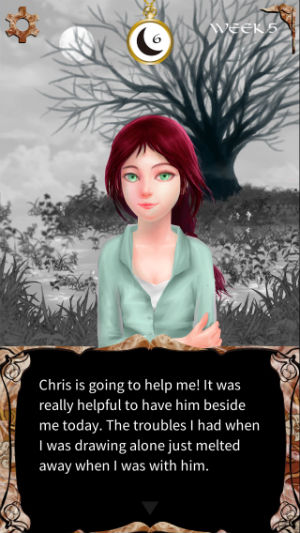Not many video games, especially causal ones you can play on your phone, attempt to address mental health issues and disorders. Who Am I tries to buck the trend with addressing the effects of Dissociative Identity Disorder (DID). In this endearing “Choose Your Own Adventure” -style game, you play as 14-year-old Dorothy Watson, a young girl in middle school who is so deeply troubled after an early traumatic experience. So much so, her personality has broken up into different parts that fight against each other and make her anxious. It is your job as counselor to bring these personalities together as a cohesive part of Dorothy.

When you start the game, you are given the option to play Week 0, which serves as a tutorial level. During Dorothy’s “Dream Time”, you speak to Dorothy and the three distinct personalities inside her head: Alice, who acts like a small child and doesn’t want to face up to reality; black hoodie wearing Gretel, who is very angry and aggressive; and cheery Cindy, who is optimistic about life and concerned that Dorothy is not getting out of her shell. The objective of the game is to get each personality to integrate with Dorothy by raising their integration bar in each counselling session whilst making sure that Dorothy does not get too stressed when you are asking questions about her life.

A neat touch to the game is that the scenarios are randomised, so the Week 1 scenario I faced in my first playthrough was different to the one I faced in my second playthrough. Your choice of dialogue can negatively affect Dorothy by making her more stressed whilst raising the integration of a certain personality, meaning that it can be quite hard to strike an effective balance. For example, I found it very hard to talk to Dorothy about her previous childhood trauma without her stress levels going dangerously high. This was a good way to illustrate how difficult counselling can be in real life.
Sometimes you will get a clue as to which personality you should be talking to after Dorothy has discussed her day. For example, one week she rescues a real bunny from a forest and calls it Snowy. The name she gives it is the same name as the imaginary bunny her childish personality, Alice, refers to. This is your cue to talk to Alice and attempt to raise her integration with Dorothy.

The only downside to the game is some of the phrasing of language and noticeable typos within the text based dialogue. The developer is not a native English speaker and had the game fully translated, but some sentences did seem off and occasionally put me in danger of causing a game over. For example, my three dialogue options in one of my conversations with Alice was “How are you?”, “Who are you?”, and “What’s your ideal type?”. I picked the third one, which seemed to scare her off and raised Dorothy’s stress levels.
Also, mental health experts may feel that by having Dorothy’s personalities as beings you can talk to during “Dream Time”, the game is over simplifying what is a debilitating and serious illness, as this would be physically impossible to do in a real situation.
On the whole, I feel that Who Am I is a brave and unique take on mental illness. According to the Positive Outcomes for Dissociative Survivors (PODS) project, “dissociative identity disorder is almost exclusively caused by repeated childhood trauma in the absence of appropriate parental support”, which we do see clearly within Dorothy’s description of her life years before.

By getting to speak to each personality, you do feel like you are helping the whole person, and you get the impression that this is a coping mechanism Dorothy has developed. Onaemo Studio’s app therefore teaches the player the nature of DID effectively, distinguishing it from other mental health issues such as schizophrenia or obsessive compulsive disorder (OCD).
If further refined and developed, this app could be a useful tool for those studying psychiatry or counselling. Tweaks also need to be made to the written conversations in future updates so that is easier to follow – especially given that text is the driving force behind the game.
Who Am I: The Tale of Dorothy is available now from the Android App Store for $1.99 and the iPhone App Store for $0.99.
Have you played this app? Do you think that it tackled mental health issues effectively? Let us know in the comments below!






Published: Jul 4, 2017 10:57 am